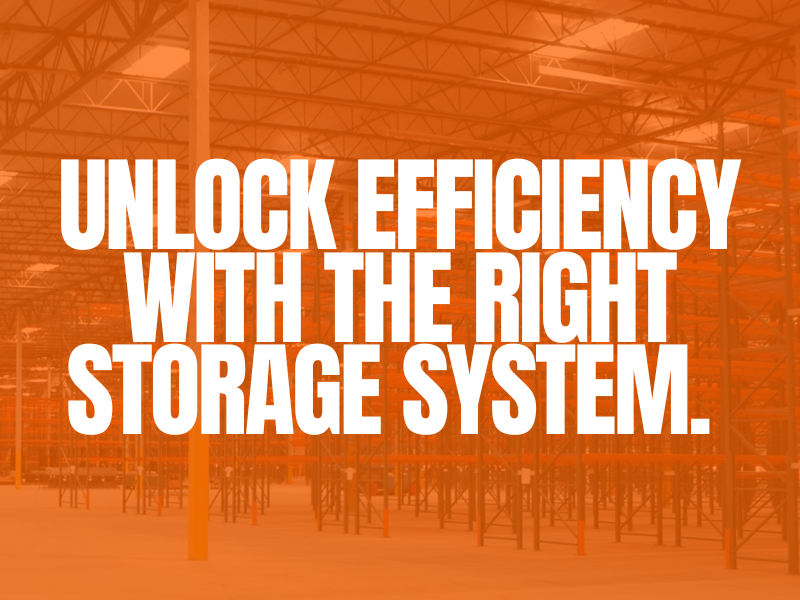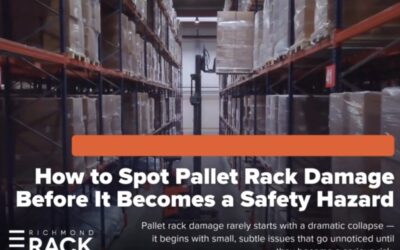From Beams to Bays: A Facility Manager’s Guide to Pallet Rack Systems
In the fast-paced world of warehouse and distribution operations, storage decisions directly impact throughput, safety, and bottom-line performance. Pallet racking systems are at the heart of this storage infrastructure — but with multiple configurations and specialized uses, choosing the right type can feel complex.
In this guide, we break down the main types of pallet racking, explain the core structural components, and provide a practical framework to help you choose what works best for your facility.
Types of Pallet Racking Systems
There are six primary racking systems commonly used in warehouses and distribution centers, each with unique tradeoffs in storage density, accessibility, and inventory flow:
- Selective Racking
- Double-Deep Racking
- Push-Back Racking
- Pallet Flow Racking
- Drive-In Racking
- Drive-Thru Racking
- Cantilever Racking (special-use; briefly discussed)
1. Selective Pallet Racking
The most common and versatile system. Allows direct access to every pallet and works with standard forklifts. Ideal for high SKU counts, FIFO inventory, and operations with low inventory turnover.
Best For: General warehousing, retail, manufacturing, pharma, and food & beverage.
Pros:
- Direct access to every pallet
- No specialized equipment needed
- Cost-effective and easy to maintain
Cons:
- Lower storage density
- Requires more aisles
2. Double-Deep Racking
A modified selective rack that stores pallets two deep instead of one. Offers more storage capacity but limits accessibility.
Best For: Warehouses with multiple pallets per SKU and lower pick frequency.
Pros:
- Higher density than selective racking
- Space-efficient layout
Cons:
- Requires double-reach trucks
- Reduced pick selectivity
3. Push-Back Racking
Uses carts on inclined rails. Each pallet pushes the next one back and gravity rolls it forward during unloading. Supports LIFO inventory.
Best For: SKUs with high pallet counts per lane that don’t require strict FIFO.
Pros:
- High storage density
- Faster picking than drive-in racking
- No specialty equipment needed
Cons:
- One SKU per lane
- Uniform pallets required
4. Pallet Flow Racking (Gravity Flow)
Roller-based system for high-density, FIFO storage. Pallets are loaded from one end and flow by gravity to the other.
Best For: Fast-moving SKUs, cold storage, grocery and food distribution.
Pros:
- Excellent for FIFO inventory
- Ideal for high-throughput environments
- Reduces labor and travel time
Cons:
- Higher installation and maintenance complexity
- Requires high-quality pallets
- Limited SKU flexibility
5. Drive-In Racking
Forklifts enter from a single side to store and retrieve pallets. Maximizes space by eliminating aisles.
Best For: LIFO storage, dense inventory with low turnover, uniform loads.
Pros:
- Excellent for high-density storage
- Maximizes space utilization
Cons:
- High damage risk
- Poor pick selectivity
- Not suitable for fast-moving or mixed SKU environments
6. Drive-Thru Racking
Similar to drive-in but with entry and exit on opposite sides — supporting FIFO.
Best For: Cold storage, beverages, and time-sensitive products.
Pros:
- Enables FIFO
- High-density with dual-access advantage
Cons:
- Requires skilled forklift operation
- Limited SKU variation
7. Cantilever Racking (Special Use)
Cantilever racking is designed for non-palletized items like lumber, pipes, or textiles. It offers easy access to long, bulky materials, but is not typically used in traditional pallet-based storage.
Best For: Building materials, furniture, or any oversized goods stored horizontally.
Understanding the Parts of a Pallet Rack
Every pallet rack system, regardless of type, is composed of structural components that support stability, safety, and performance. Here’s a functional breakdown:
- Upright Frames (Posts):
The vertical columns that form the racking structure. Typically perforated to accept horizontal beams at different heights. - Beams (Cross Beams):
Horizontal members connecting the uprights. They carry the load of the pallet and define each storage level. - Footplates (Baseplates):
Anchor the uprights to the floor, ensuring structural stability. - Shelf Panels or Decking:
Optional horizontal surfaces (wood, metal, or wire) used to store non-palletized loads or offer full support under pallets. - Crossbars (Load Supports):
Added perpendicular supports under beams to prevent pallets from sagging or falling through. - Diagonal Struts and Bracing:
Reinforce upright frames for rigidity and help prevent sway. - Shims:
Level the racking system on uneven warehouse floors. - Fasteners, Clips, and Row Spacers:
Secure components together and maintain consistent spacing between rows or back-to-back frames.
Frequently Asked Questions
What is pallet racking?
A pallet racking system is an industrial shelving structure used to store palletized goods in horizontal rows and multiple vertical levels. It allows for efficient use of vertical space and seamless forklift access.
What is the most common type of racking?
Selective pallet racking is the most widely used due to its simplicity, flexibility, and affordability.
Are there different ways to stack pallets?
Yes.
- Floor stacking: Pallets placed directly on the warehouse floor
- Block stacking: Floor stacking with pallets stacked on top of each other
- Rack stacking: Uses pallet racking to increase vertical storage and organization
Final Thoughts: A Strategic Approach to Rack Selection
Choosing the right pallet racking system is more than a layout decision — it’s a strategic move that affects labor efficiency, inventory turnover, space utilization, and safety.
Before investing, take the time to evaluate your:
✔ Inventory types and SKUs
✔ Turnover and handling frequency
✔ Equipment compatibility
✔ Future expansion needs
A Word of Caution: Be Careful with Used Racking
While used racking can seem like an attractive cost-saver, it’s critical to remember that pallet racks are engineered for specific loads based on frame gauge, beam size, and anchoring design. Pre-owned racking may lack manufacturer documentation, suffer unseen damage, or fail to meet your required load capacity. Always have used racking professionally evaluated and never assume compatibility with your existing systems.
Need Expert Help?
At PeakLogix, we specialize in designing, sourcing, and integrating warehouse storage systems that match your operation’s exact needs — whether you’re building from the ground up or optimizing an existing layout.Contact us today for a personalized pallet racking consultation.

